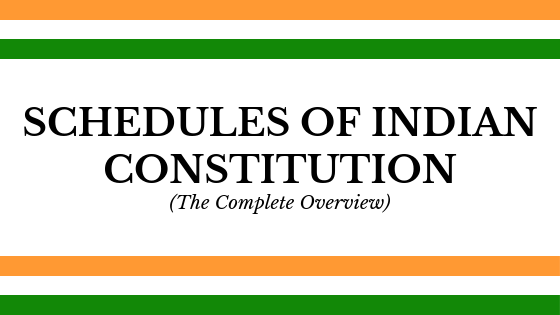In the present day, the Constitution of India has a total number of 448 articles. These 448 articles can be further categorized into 25 parts and 12 schedules of the Indian constitution.
In this article, we will study the history and key features of the constitution, along with an in-depth understanding of the 12 schedules.
The History of the Indian Constitution at a Glance
- The Constitution of India or the Bhāratīya Saṃvidhāna, put in the clearest terms, is the supreme law of India.
- This document sets down a structural framework that strictly distinguishes between the foundational political code, structure, powers, procedures, duties and the powers of government institutions. The document lays down directive principles, fundamental rights, and the duties of citizens.
- Our constitution is the longest written constitution of any country. The chief architect behind it’s making is Dr. B. R. Ambedkar, who was the then chairman of the Drafting Committee.
Key Features to Remember
- The constitution of India was drafted by a Constituent Assembly and not the parliament. Therefore, it advocates constitutional supremacy and not parliamentary supremacy.
- The parliament cannot overrule the constitution.
- The document was appointed on 26 November 1949 by the Constituent Assembly. It became operative on 26 January 1950. We were first declared a Republic officially in the document on this date, hence 26 January is celebrated as India’s Republic Day.
- Prior to the Constitution of India, the fundamental governing document of the nation was the Government Of India Act, 1935
- As per our constitution, India is : –
- a sovereign,
- socialist,
- secular,
- democratic republic,
- assuring its citizens
- justice,
- equality and
- liberty, and
- endeavors to promote fraternity.
“Secular” and “Socialist” were later added to the preamble during the emergency in 1976.
What are schedules in Constitution?
To define, Schedules are the lists declared in the constitution that classifies and tabulates government policy and bureaucratic affairs. In other words, these are tables that contain all the additional information not found in the articles.
How many Schedules are there in our Constitution?
In its infancy, the Indian Constitution had a total of eight schedules. At present, the total number of schedules stands at 12, after 4 new schedules were added through different amendments.
Now, let us read about the 12 schedules in detail:-
The schedules of the Indian constitution
- First Schedule (Article 1, Article 4)
This schedule contains India’s states and union territories; the alterations in their borders, and the different laws that must be followed to make such alterations.
- Second Schedule (Articles 59(3), 65(3), 75(6), 97, 125, 148(3), 158(3), 164(5), 186 And 221)
This schedule consists of the salaries of the comptroller and auditor general, public officials and judges.
- Third Schedule (Articles 75(4), 99, 124(6), 148(2), 164(3), 188 And 219)
The forms of oath or affirmation are listed here. It details out the different oaths of office for judges and elected officials
- Fourth Schedule (Articles 4(1) And 80(2))
This enlists the total number of seats allocated to the Upper House of the Parliament Or the Rajya Sabha on the basis of state/union territory.
- Fifth Schedule (Article 244(1))
It lists the provisions for administration and control of scheduled tribes and scheduled areas.
- Sixth Schedule (Articles 244(2) And 275(1))
This lists down the provisions created for the administration of the tribal territories in the states of Meghalaya, Assam, Mizoram, and Tripura
- Seventh Schedule (Article 246)
It consists of the Union List (Central Government), State List (State), and the Concurrent List.
- Eighth Schedule (Articles 344(1) And 351)
This lists out the prevalent recognized and official languages.
- Ninth Schedule (Article 31-B)
This contains provisions relating to the validation of specific acts and regulations.
- Tenth Schedule (Articles 102(2) And 191(2))
This lists the anti-defection provisions for members of Parliament and state legislatures. These provisions form the benchmark for disqualification on the grounds of defection.
- Eleventh Schedule (Article 243-G)
This contains the allocated power, responsibilities and authority of the rural local government or panchayats.
- Twelfth Schedule (Article 243-w)
This schedule of the Indian constitution contains the allocated power, responsibilities and authority of the urban local government or municipalities.





